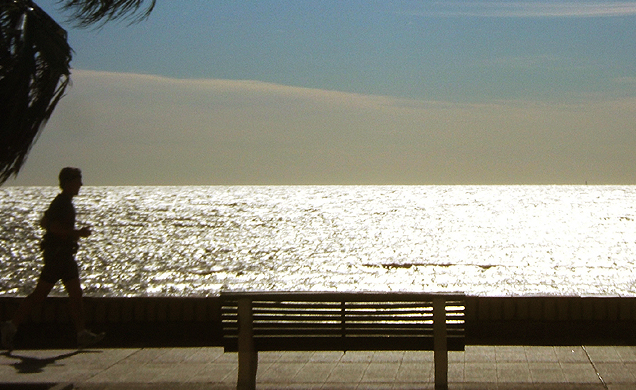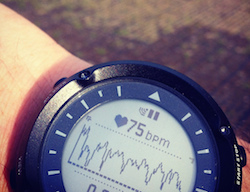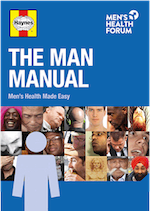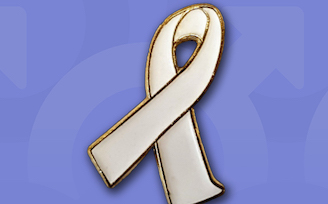Jogging: easier than you think

Spare tyre not going away? Breathless after climbing stairs? Or perhaps you’re inspired by the C25K programme, an NHS-backed initiative which aims to get just about anyone from the couch to running in nine weeks.
Whatever the reason, there comes a time in a man’s life when he figures that if doesn’t start exercising again, he probably never will. The implications for your health of not realising it are grave. It happened to me in my mid-40s.
You only need one piece of advice
Now some people like to make things more complicated than they really are but the truth is pretty much anyone can take up jogging. (But if you aren't used even to walking you should definitely do that first). All the advice in those books, magazines and websites boils down to one thing: don't get injured.
Most runners get injured - two thirds according to the Guardian, 79% according the New York Times. And the risk gets higher the older your body is when you start putting it through its paces. If you’re injured you can’t run and may have to quit altogether - many runners do.
A useful maxim is: don't do more today than you will be able to do tomorrow. It's easy in a burst of enthusiasm to run far too far, too quickly with the result that your legs are battered and aching for days afterwards and you don't go out again.
Why starting-over joggers get injured
The typical pattern is this: you take it very easy at first, gradually go a little faster for a little longer and then on the sixth or seventh run, you get injured. The reason is that your cardiovascular performance (your heart and lungs) rises to the task quicker than your muscles and skeleton.
You notice by the third or fourth run that you're already not so breathless as you were the first time. You're really pleased and rightly so. It's a good sign for your lungs. But it doesn't mean that the rest of your body has improved at the same pace — building up effective muscles takes longer. Pushing them to the new limit that you believe your heart and lungs will allow you to will result in injury. Happens time and again.
Your body will tell you all this but you need to learn to listen to it. It's easy — especially for we men who aren't great at listening and believe in that 'no pain, no gain' nonsense - to run through aching legs, especially when your heart appears to be telling you that it's OK. But that pain is there for a reason and, if you ignore it, the muscle will give out on you. At best, it'll be back to square one; at worst, you join the hordes who drop out of exercise through injury.
Starting-over joggers should not run everyday — certainly not at first. Often the after-effects are more noticeable two days after running than the following morning. Taking your time helps you get to know your body and how it reacts to what you're putting it through.
Warming-up
The time of day at which you run makes a big difference. 10am is the peak time for heart attacks, Monday the most popular day. You don't need to be old to have a heart attack - remember footballer Fabrice Muamba on the pitch at White Hart Lane.
Plus, the muscles are tighter after a night in bed than after a day in action. For these reasons take it easier in the morning.
Take longer warming up in the morning. Warm-up for longer the older you are and the longer you will be jogging for. Similarly with warming down. Make sure you warm up and down the right muscles — this is relatively easy with jogging as walking will do this.
 You only need one gadget
You only need one gadget
Apart from decent running shoes and socks, you don't need much equipment to jog but there is one gadget which will help: a heart-rate monitor. A basic one is all you need. It can hook up with your smartphone. It will take account of some of the factors that you might not. Mine showed me how much higher my heart rate was in the morning, for example.
For your heart and muscles to get the most out the exercise the experts reckon you need to exercise at between 60% and 85% of your maximum heart rate.
This zone ensures your heart works hard enough to improve it but not so hard that it damages itself. Your maximum heart rate is 220 minus your age so mine was 220-43=177. So my safe zone is a pulse of 115 beats per minute to 150. A heart rate monitor can keep you in this zone. Run until you get out of the zone then walk until you're comfortably back in it again.
Your effective cardiovascular exercise time is the time you spend in this safe zone not the time you spend running. So time spent walking in the zone is effective too and puts less strain on your muscles and joints. In other words, at the start you can happily spend a lot of the time walking and still get the benefit to your heart. Now, tell me that the body is not beautifully designed.
Time spent below the zone is not doing so much for your heart and lungs but will still exercise your body. Spend too long above the zone and, unless you are a genuinely fit athlete, you're not helping yourself.
Build up slowly. Just a minute more or 50 yards further is fine. You don't even need to do more each time so long as you're going in the right general direction. Do this without injury you may even start to enjoy it. You won't if you're a hobbling wreck after a week.
It worked for me - until I did my knee in playing tennis.
- Jim Pollard is editor of the Men’s Health Forum’s website and author of The User’s Guide To The Male Body.
|
The Men’s Health Forum need your support It’s tough for men to ask for help but if you don’t ask when you need it, things generally only get worse. So we’re asking. In the UK, one man in five dies before the age of 65. If we had health policies and services that better reflected the needs of the whole population, it might not be like that. But it is. Policies and services and indeed men have been like this for a long time and they don’t change overnight just because we want them to. It’s true that the UK’s men don’t have it bad compared to some other groups. We’re not asking you to ‘feel sorry’ for men or put them first. We’re talking here about something more complicated, something that falls outside the traditional charity fund-raising model of ‘doing something for those less fortunate than ourselves’. That model raises money but it seldom changes much. We’re talking about changing the way we look at the world. There is nothing inevitable about premature male death. Services accessible to all, a population better informed. These would benefit everyone - rich and poor, young and old, male and female - and that’s what we’re campaigning for. We’re not asking you to look at images of pity, we’re just asking you to look around at the society you live in, at the men you know and at the families with sons, fathers and grandads missing. Here’s our fund-raising page - please chip in if you can. |


